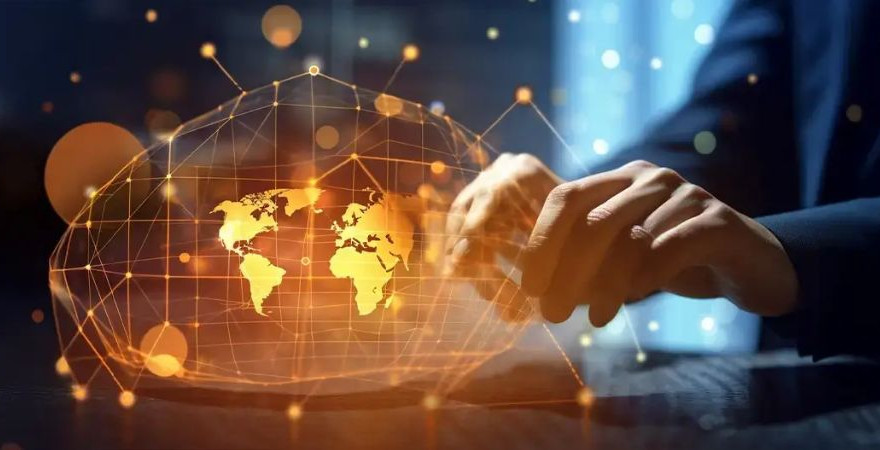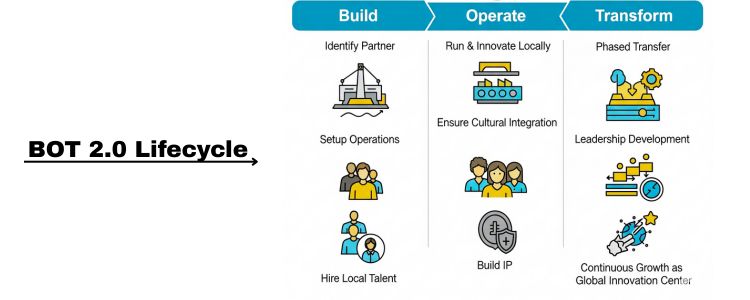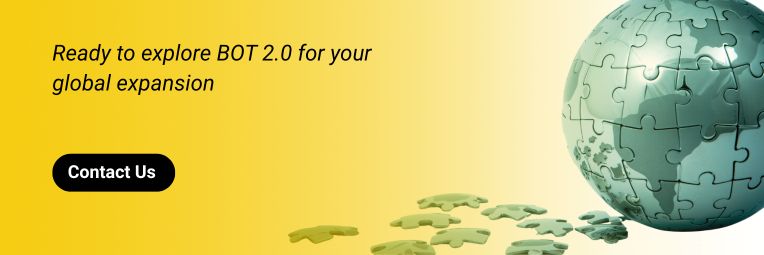
In 2025, companies are expanding faster than ever. But it is not easy to install a Global Innovation Centre (GIC) or a Global delivery Model (GDM) in a new country. High costs, regulatory barriers, and talent deficiency often slow down global expansion. However, India is changing this story. India has over 1,900 Global Capability Centers (GCC) or global captive centers, which contribute to the export of $64 billion annually. By 2026, India’s GCC region is expected to grow more, with Tier 2 cities like Coimbatore, Jaipur, and Bhubaneswar emerging as new centers. This economic development, number of talents, and government-friendly policies have made India a major center for companies using the build-operate-transfer (BOT) model, especially for its modern version: BOT 2.0.
Traditional outsourcing helped reduce costs. But today businesses need control, measuring, and innovation, not a saviour. Older models such as joint ventures or simple outsourcing fall short. BOT 2.0 is a solution. Unlike earlier models, which were focused only on “transfer after operation,” BOT 2.0 integrates innovation, capacity building, and IP retention from day one. Global companies now use BOT 2.0 not only to create an office but also to create a global innovation center that directly speeds up their development.
In BOT 2.0, the “Transfer” phase has transformed into “Transform.” Here’s how: This new approach allows companies to build teams that innovate locally but think globally, delivering long-term growth. This new approach allows companies to create teams that innovate locally but think globally, which leads to long-term development.
In India, GCC now not only covers IT, but also covers BFSI, Retail, Health Services, AI and Analytics, and engineering designs.
India remains a pioneer, but companies are exploring possibilities in these areas as well: However, government incentives such as India’s deep talent, digital infrastructure, PLI schemes, and SEZ benefits give it a clear lead.
To succeed in BOT 2.0, companies require a clear strategy. These five columns help them ensure success: The journey of BOT 2.0 should be aligned with global business goals—not only with local outsourcing requirements. Companies have to define what they want from the centre: innovation, process control, or capacity building. It is important to select a reliable GCC service provider or BOT partner in India. The partner should provide both strategic counselling and operational execution expertise. Both the company and the local partner should share the KPI from the beginning. A joint governance structure helps in transparent monitoring of quality, productivity, and innovation results. The company should make appointments under its brand, not under the seller’s brand. This strengthens the local appearance, improves employee retention, and ensures cultural alignment. Transfer should not be the ultimate goal—this change should begin. After transfer, continuous leadership development, skill upgradation, and innovation pipelines are required.
Yes, the future is pointing to BOT 3.0. In BOT 3.0, companies do not move only operations. They develop them in the Center of Excellence(COE). After the transfer phase: And What’s Exciting? Bot as a service may soon be made available to moderate-sized companies and SMEs, which will make global expansion easier for even small firms. BOT 3.0 is about continuous changes rather than only installing and handing over.
In 2023, an American retail giant used BOT 2.0 to create an analytics team with 500 members in Hyderabad. In 18 months:
For companies with global goals, BOT 2.0 is no longer an outsourcing option; it is a strategic tool for global innovation. BOT 2.0 is strengthening the future of global expansion as India’s GCC ecosystems flourish and economic benefits grow.
Inductus GCC, as a leading GCC enabler in India, helps global firms to avail BOT 2.0 to make scalable, innovative, and global distribution centers ready for the future.
BOT is a commercial model where companies form and operate a center in association with local experts and later take full control of it. The BOT 2.0 helps companies to enter new markets rapidly, create local talent teams, and control operations without any heavy investment. India provides a huge talent pool, cost profit, strong digital infrastructure, and trade-friendly government policies for global companies. A global innovation center focuses more on product development and innovation, while a GCC can handle both operations and innovation. Typically, it takes 12 to 24 months for the construction, operation of the center, operating, and the original company completely. Aditi, with a strong background in forensic science and biotechnology, brings an innovative scientific perspective to her work. Her expertise spans research, analytics, and strategic advisory in consulting and GCC environments. She has published numerous research papers and articles. A versatile writer in both technical and creative domains, Aditi excels at translating complex subjects into compelling insights. Which she aligns seamlessly with consulting, advisory domain, and GCC operations. Her ability to bridge science, business, and storytelling positions her as a strategic thinker who can drive data-informed decision-making.
Why BOT 2.0 ?
What is BOT 2.0?
Aspect
BOT 1.0
BOT 2.0 (Today)
Focus
Setup and Transfer
Setup, Operate, and Transform
Talent Role
Execution
Innovation and Problem Solving
IP Control
Limited
Full Control from Start
Cultural Alignment
Low
Embedded during Operations
Transfer Outcome
Support Centre
Global Innovation Centre (GIC)
Why Bot 2.0 for Global Expansion?

Bot 2.0 Emerging Hotspot
5 Columns of Success of BOT 2.0
Future Approach: Is BOT 3.0 Coming?
Case Insight
Conclusion
frequently asked questions (FAQs)

Aditi
Hey, like this? Why not share it with a buddy?
Related Posts
Recent Blog / Post
- The Legal and Compliance Checklist for a New GCC Setup October 4, 2025
- The Rise of Niche GCCs: A Focus on Specialised Capabilities October 4, 2025
- The Impact of Regulatory Changes on GCC Operations October 4, 2025
- Cybersecurity for GCCs: A Proactive Approach to Data Protection September 30, 2025
- Beyond Cost: Measuring the True ROI of Your GCC Investment September 29, 2025
- The Future of GCCs in the Retail Sector: A Strategic Playbook September 29, 2025
- David vs Goliath: Mid-Sized GCCs Quietly Outperform the Big Brands September 29, 2025
- Infineon’s Big Bet on India: Inside Its First GCC in GIFT City September 29, 2025
- From Campuses to Capability Centres: How Indian Universities Power the Global GCC Ecosystem September 29, 2025
- Retail Meets Digital: Costco’s GCC in Hyderabad Marks a Global Shift September 29, 2025
- The Silent Crisis: Why Many GCCs Plateau After 3 Years and How to Avoid It September 24, 2025
- Germany’s New Skilled Immigration Act and Its Ripple Effect on the GCC Talent Model September 24, 2025
- From Tokyo to Hyderabad: The Future of GCCs for Japanese Conglomerates September 23, 2025
- GCCs as AI Acceleration Hubs: Collaborating with US and Nordic Tech Majors September 19, 2025
- Breaking the Tech Ceiling: How Women Leaders Are Reshaping India’s GCC Landscape September 19, 2025
















